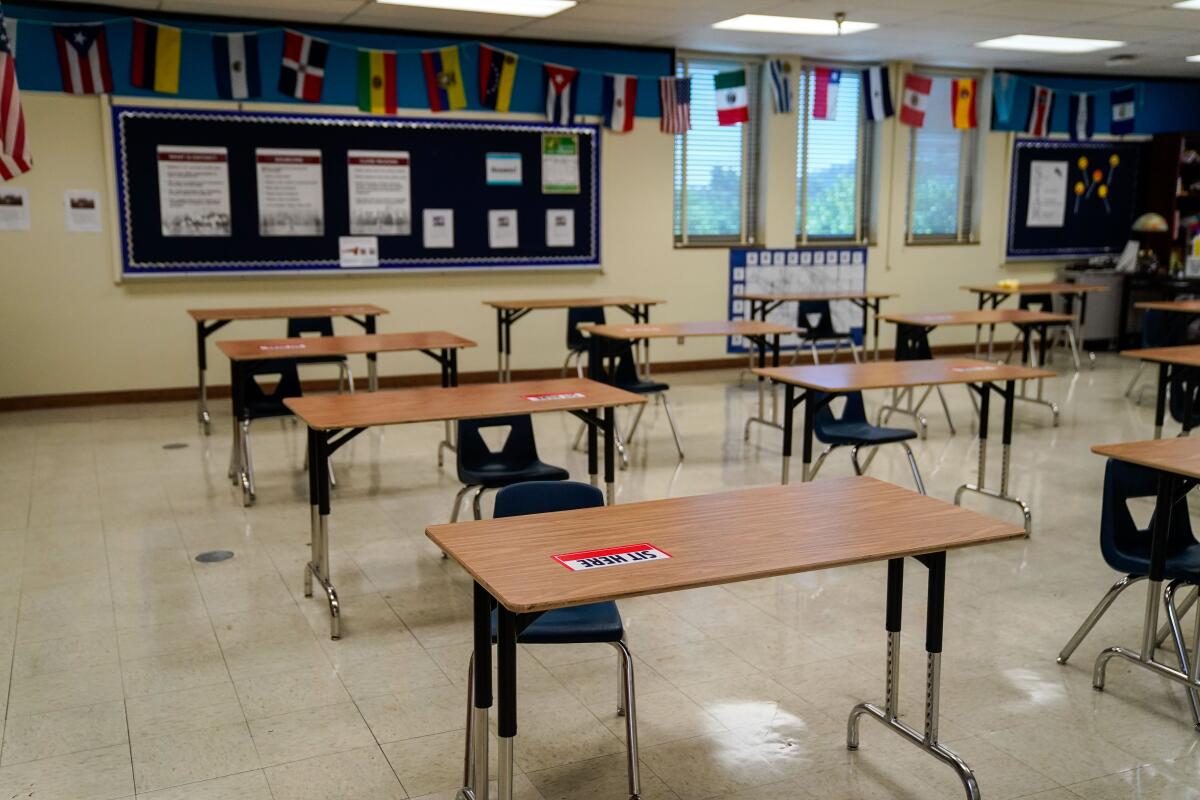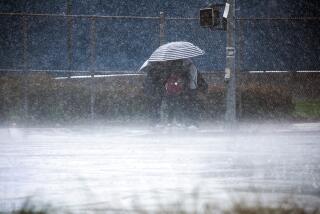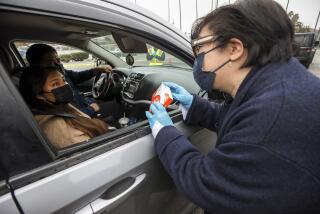Schools in L.A. County will not be allowed to fully reopen until at least November

No campus in Los Angeles County will be allowed to reopen to all K-12 students until at least November, although schools can begin to offer small in-person classes for children with special needs at no more than 10% of capacity at one time, county Public Health Director Barbara Ferrer said Thursday.
The news will be a blow to students, parents and educators who have been hoping that progress against the coronavirus might allow for campuses to reopen on a faster tract. However, the small in-person classes for children who need special services, announced last week, could allow at least 200,000 students back to campus across the county.
No districts are currently required to offer in-person services to students — and officials with both the L.A. Unified School District and the district’s teachers union have said they are opposed to any full campus reopenings at this time, citing safety concerns.
Some smaller school districts and private schools had hoped to open elementary campuses through a state-permitted waiver process, but Ferrer said that the county would not grant waivers. State guidelines allow for such waivers to help young students who have particular difficulties with online learning.
Ferrer explained the county’s new policies in two calls Thursday with school and district leaders. One was a health department briefing; the other was a briefing arranged by the L.A. County Office of Education, which provides support services to the county’s 80 school districts. The Times was able to listen to both briefings.
As Ferrer explained, the county’s approach is part of a multipronged state and county effort to open schools safely.
First, small groups can begin coming to campuses as soon as Monday and no approval from the county is required provided that schools attest that they are following required safety guidelines.
The students who come back must be defined as having special needs. Top priority will be given to students with disabilities and students who are learning to speak English. Schools and school districts have flexibility to identify which students need in-person instruction. Students who need in-person assessments also will be prioritized.
Students can meet one-on-one with a teacher or another staff member or in groups as large as 12 with as many as two adult supervisors or teachers.
A campus cannot be at more than 10% of capacity at any given time. However, there is no defined limit on how many students can be served over multiple days. For example, one group of students could be served on campus two days a week and another group on a different two days. Such a plan could add up to a lot of students, close to 100,000 in Los Angeles Unified alone, for example.
School leaders on the call with Ferrer expressed some excitement about the possibility of bringing some students back — potentially with minimal delay. It was an opening for which they had been waiting.
In a snap poll of 50 district leaders on one call, 72% said their school system would definitely or probably reopen for small groups; 24% were undecided, and 4% said probably not. No one chose definitely not. It was not clear which of the county’s 80 school districts were on the call.
But district leaders also expressed concern about winning necessary support from employee unions.
If confronted by teacher opposition, Ferrer suggested that, at the least, students could be brought to campus for services that did not involve teachers.
Some advocacy groups want the L.A. district to push harder toward opening campuses for students with special needs.
But parents throughout the county are divided over the pace of reopening.
Burbank PTA President Wendi Harvel says the No. 1 feedback she’s received from parents is return to campus only “when it’s safe.”
“There are a few parents I’ve spoken to who do want to get back to school soon, but the majority are being cautious and want to see conditions improve,” said Harvel, whose children are taking their high school and middle classes online.
In a Facebook video last week, L.A. teachers union President Cecily Myart-Cruz said the union would block any return to campus by students or teachers. On Thursday, the union clarified that stand, saying that Myart-Cruz spoke forcefully because she wanted to ease the concerns of members who’d just learned about the state clearing the way for small groups at schools — some teachers feared being forced back to campuses immediately.
“We’re not opposed to a safe reopening of our schools for a small targeted population of students,” said Gloria Martinez, a vice president for United Teachers Los Angeles. “However, at this point we’re concerned about whether the district has the appropriate funding and resources to ensure the safety of our students and members. If the district thinks it is in a position to open campuses safely for this purpose, we are open to meeting with them.”
Some of the students targeted for help in the small-group plan, such as English learners, live in parts of the district that have the highest COVID-19 infection rates, which complicates efforts to provide face-to-face assistance.
L.A. school officials had no immediate comment Thursday.
The county plans to study data from this smaller-scale start-up over the next six weeks before making any conclusions about a broader school reopening, Ferrer said. That’s why a general reopening won’t happen until at least November.
Several months ago, officials had planned for campuses to reopen in the fall, but this target was pushed back indefinitely by Gov. Gavin Newsom in July. Now, school reopenings are based on a county’s pandemic health status or the approval of the waiver applications for elementary schools.
L.A. County is in the highest tier for danger from the pandemic, which means a general reopening of schools is not currently permitted under state orders.
Long Beach Unified, the county’s second-largest school system, told parents Thursday that the district would continue online-only instruction through the winter break to provide instructional stability.
Supt. Jill Baker said, in a video broadcast, that there is a “higher likelihood of contributing to the spread of a communicable disease” when large groups of adults and students are at one location. And pending the availability of a vaccine, surges in infections could perpetuate “a cycle of opening and closing classrooms.”
Both Long Beach and L.A. school systems are working on plans to provide help for students with special needs.
Times staff writer Andrew J. Campa contributed to this report.
More to Read
Sign up for Essential California
The most important California stories and recommendations in your inbox every morning.
You may occasionally receive promotional content from the Los Angeles Times.











